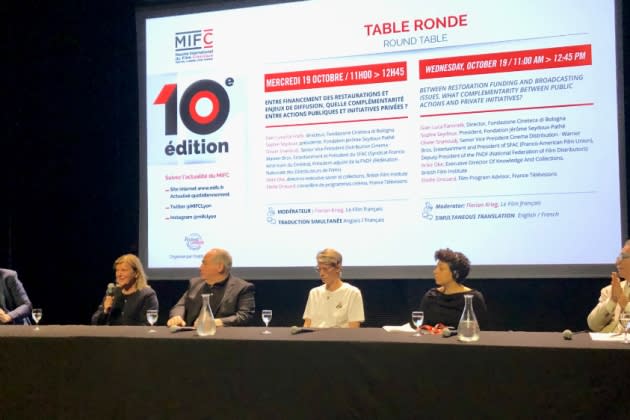Classic Film is Everyone’s Business, Say Key Players at Lumière’s Film Market

Both public action and private initiatives will ensure heritage film is preserved and distributed, said key players gathered for the 10th edition of the Classic Film Market in Lyon.
The round table brought together Sophie Seydoux, president of the Fondation Jérôme Seydoux-Pathé; Olivier Snanoudj, senior VP cinema distribution at Warner Bros. France; the BFI’s Executive Director of Knowledge and Collections, Arike Oke; Elodie Drouard, film program advisor at France Télévisions, and the Cineteca di Bologna head, Gian Luca Farinelli.
More from Variety
BAFTA-Winning 'After Love' to Open BFI and BBC British Film Premiere Season - Global Bulletin
BFI Reveals Details of $17 Million Audience Projects Fund - Global Bulletin
U.K. Cinema Titans Convene at BFI Luminous Gala to Celebrate Next Generation of Filmmakers
On film restoration funding, all agreed it cannot happen without public aid.
“Public funding represents about 22% of our restoration costs. Economic profitability is impossible on restorations, we couldn’t do it without the CNC [the national film fund],” said Seydoux, whose foundation – a separate entity from Pathé, dedicated to the preservation, restoration and promotion of film heritage belonging to the historical French company – restores around 15 films a year.
The same goes for the British Film Institute’s archives, which receives some 40% of its budget through grant-in-aid, a direct subsidy from the U.K. government, said Oke. Other sources include philanthropic trusts – notably Martin Scorsese’s Film Foundation – the National Lottery fund, publishers and industry partners.
In Italy, “public contribution is essential,” said Farinelli, who lamented recent changes in the law cutting public subsidies for film restoration, adding: “The Cineteca relies on private organizations for approximately one third of the cost of restorations. That’s very important, especially as it’s rare for rights holders in Italy to put money into film restoration.
“I don’t understand this passivity on the part of private players: There are companies with outstanding catalogues, managing hundreds if not thousands of titles, and they do nothing,” said Farinelli, who also regretted a lack of public policies to support the broadcasting of Italian heritage cinema on public TV.
France Télévisions, on the other hand, has four regular TV shows dedicated to cinema, including two on heritage cinema – one of them, “Cinéma de Minuit” is a national institution, which has been around for nearly half a century, said Elodie Drouard.
This terrestrial offer is complemented by France Televisions’ platform, France.tv, which aims to “offer about 200 films per year, separate from our offer on terrestrial,” she explained.
“What this allows us to do is offer movies where there is no positioning on terrestrial TV. For example, being a partner of the Lumière Festival provides us with a golden opportunity to show the diversity of heritage cinema: If you go to our platform, you will discover Godard’s doc “Histoire(s) du Cinéma” and some of his shorts, along with a collection of seven Wim Wenders films, and “Big Fish” by Tim Burton,” she said.
Burton is the recipient of the festival’s lifetime achievement Lumière Award at this year’s edition.
Film festivals like Lumière, and especially Cannes, are ideal partnering events for channels and studios to boost the visibility of heritage films.
“It’s part of our business model,” said Olivier Snanouj, who explained that, alongside its bread-and-butter collaborations with French distributors and the French Cinémathèque, Warner Bros France also uses festivals as a springboard for its restorations.
These range from cult classics like Stanley Kubrick’s “2001: A Space Odyssey”, whose recent restoration was overseen by Christopher Nolan and released with great fanfare as part of the Cannes Film Festival’s Cannes Classics sidebar in 2020, to Sydney Lumet restorations released to coincide with this edition of Lumière, and lesser-known works.
“A couple of years ago, at [late Lumière fest president] Bertrand Tavernier’s request, we released 10 copies of pre-Code era films that were not that well known, which got a theatrical release at Lumière,” explained Snanoudj.
Another source of income is DVD and Blu-Ray sales of heritage films, which help buoy the declining home video market. “Digitization played a huge role,” said Snanoudj. “Before the ‘80s, studios didn’t care about heritage films. With the advent of DVDs and bonus sets, everybody started looking for content in their catalogues and realized there was a need to restore the films. Thanks to DVDs and dedicated platforms, as well as certain slots on TV, there is an ongoing demand for heritage films, and that’s reassuring.”
While this may be the case, both the panel and the MIFC audience were quick to add that for this to happen, it is vital that rights holders play the game, which remains a real challenge with most major studios.
Concluding the round table, panelists concurred on the need to educate young audiences through both public policy and private initiative programs, to ensure film heritage remains a priority for generations to come.
The 10th edition of Lumière’s MIFC takes place alongside the Lumière Film Festival in Lyon, runs Oct. 19-21.
Best of Variety
The Best Pop Culture Halloween Costumes for 2022: From 'House of the Dragon' to 'Euphoria'
Constance Wu Gets Candid in Revealing New Memoir 'Making a Scene'
Sign up for Variety’s Newsletter. For the latest news, follow us on Facebook, Twitter, and Instagram.
